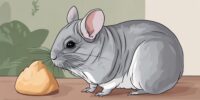How to Make Homemade Treats for Your Chinchilla Safely
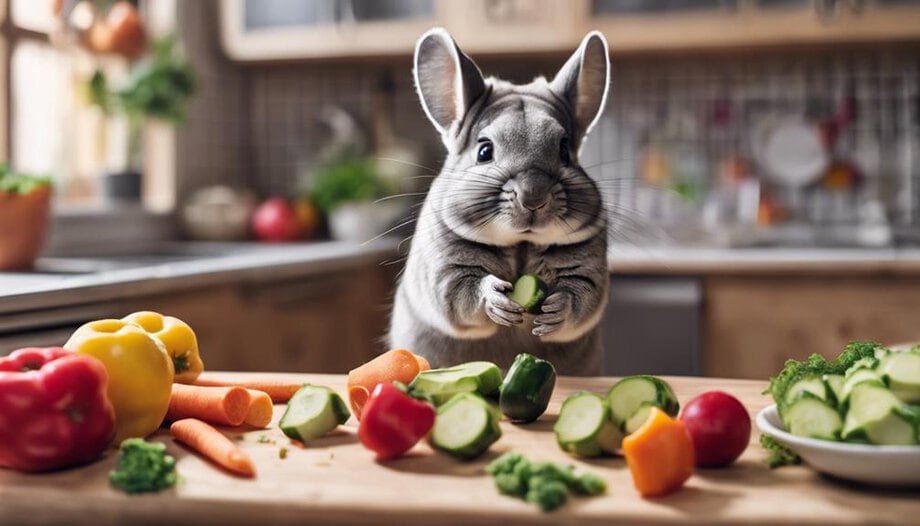
Chinchillas are adorable and playful pets that require a balanced diet to stay healthy. One way to ensure they get the nutrients they need is by providing them with homemade treats. By making your own treats, you can control the ingredients and avoid any harmful additives.
Homemade treats can be a fun way to bond with your chinchilla and provide them with a variety of flavors and textures. Some popular homemade treats for chinchillas include hay-based treats, dried fruits, and vegetables. It's essential to research which foods are safe for chinchillas before making any treats, as some foods can be harmful to their digestive system.
When making homemade treats for your chinchilla, be sure to use fresh ingredients and avoid any foods that are high in sugar or fat. It's also crucial to introduce new treats gradually to prevent any digestive upset. With a little creativity and research, you can create safe and healthy treats that your chinchilla will love.
Chinchilla Dietary Requirements
To guarantee the health and well-being of your beloved chinchilla, it's essential to comprehend their dietary requirements with precision and care. Understanding your chinchilla's nutritional needs is the cornerstone of providing proper care for these adorable creatures.
Chinchillas require a diet that's high in fiber and low in fat to maintain peak health. Hay should make up the majority of their diet, supplemented with specially formulated pellets to make certain they receive all the essential nutrients.
While it may be tempting to indulge your chinchilla with treats, it's important to be mindful of the ingredients. Opt for chinchilla treat alternatives that are specifically designed for them, avoiding sugary or fatty snacks that can disrupt their delicate digestive system.
Safe Ingredients for Chinchilla Treats
Which ingredients are safe and beneficial for creating homemade treats for your chinchilla? When preparing homemade treats for your furry friend, it is important to use safe and healthy ingredients to guarantee their well-being. Below is a table outlining some safe ingredient alternatives along with guidance on treat preparation:
| Ingredient | Benefits | Preparation |
|---|---|---|
| Rosehips | High in Vitamin C | Dried and chopped finely |
| Dandelion Leaves | Rich in fiber and nutrients | Washed thoroughly and air-dried |
| Blueberries | Antioxidant-rich | Fresh or frozen, cut into small pieces |
Homemade Chinchilla Treat Recipes
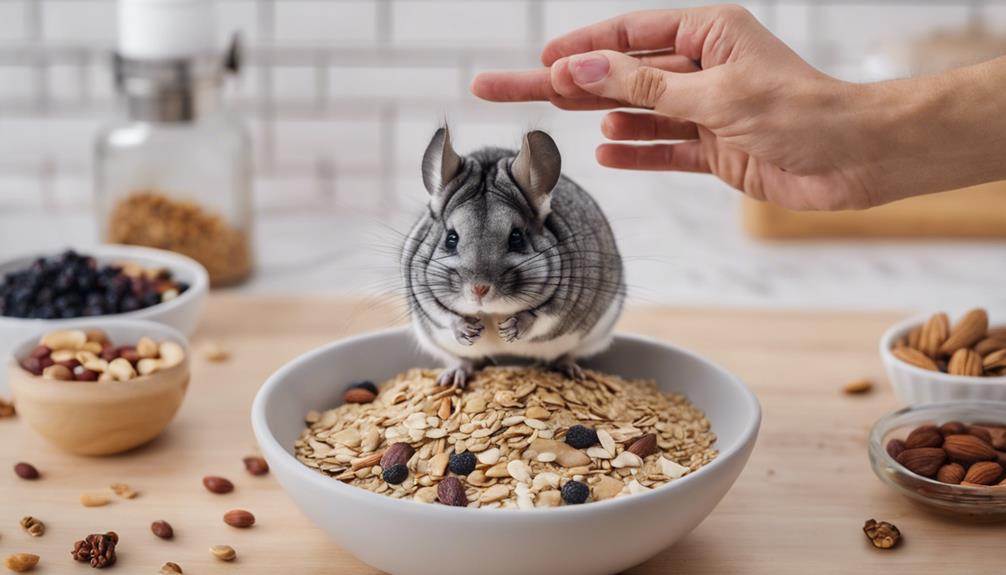
Embark on a culinary adventure for your furry friend with nutritious treat options. Discover the safe ingredients to use in your homemade chinchilla snacks.
Unveil easy homemade recipes that will delight your chinchilla's taste buds.
Nutritious Treat Options
For your beloved chinchilla's delight and health, consider crafting nutritious homemade treats using simple ingredients found in your kitchen. Here are some delightful ideas for homemade chinchilla treats that are both nutritious and easy to make:
- Hay and Herb Balls: Combine hay with chinchilla-safe herbs, roll into small balls, and bake until crispy.
- Apple and Oat Treats: Mix unsweetened applesauce with oats, form into small shapes, and bake until firm.
- Carrot and Timothy Hay Cookies: Blend carrots with timothy hay, shape into cookies, and bake until golden.
- Banana and Hay Muffins: Mash bananas with hay, spoon into muffin trays, and bake until cooked through.
Your chinchilla will surely appreciate these homemade delights!
Safe Ingredients to Use
To safeguard the well-being of your cherished chinchilla, carefully select safe and wholesome ingredients when preparing homemade treats for your furry friend.
When creating homemade chinchilla treats, it's crucial to focus on ingredient combinations that offer not only delicious flavors but also beneficial health effects. Opt for ingredients like rose hips, dried herbs, and high-fiber pellets to promote digestive health and provide essential nutrients.
These ingredient combinations can enhance your chinchilla's overall well-being and add variety to their diet. Be mindful of the health benefits each ingredient offers, ensuring that they contribute positively to your chinchilla's diet.
Easy Homemade Recipes
When creating homemade chinchilla treats, prioritize using simple and wholesome ingredients to guarantee both flavor and health benefits for your furry companion.
Here are some easy homemade recipes to treat your chinchilla to delicious and nutritious snacks:
- Apple Chew Sticks: Slice apples into thin sticks and bake until crispy for a tasty chewy treat.
- Carrot Crunchies: Grate carrots and mix with oats, then bake for a crunchy snack rich in essential vitamins.
- Banana Bites: Mash ripe bananas, roll into small balls, and freeze for a cooling and sweet indulgence.
- Pumpkin Seed Poppers: Roast pumpkin seeds until crunchy for a protein-packed snack chinchillas love.
These healthy snack options can easily be customized with ingredient substitutions to cater to your chinchilla's preferences.
Baking and Storage Tips
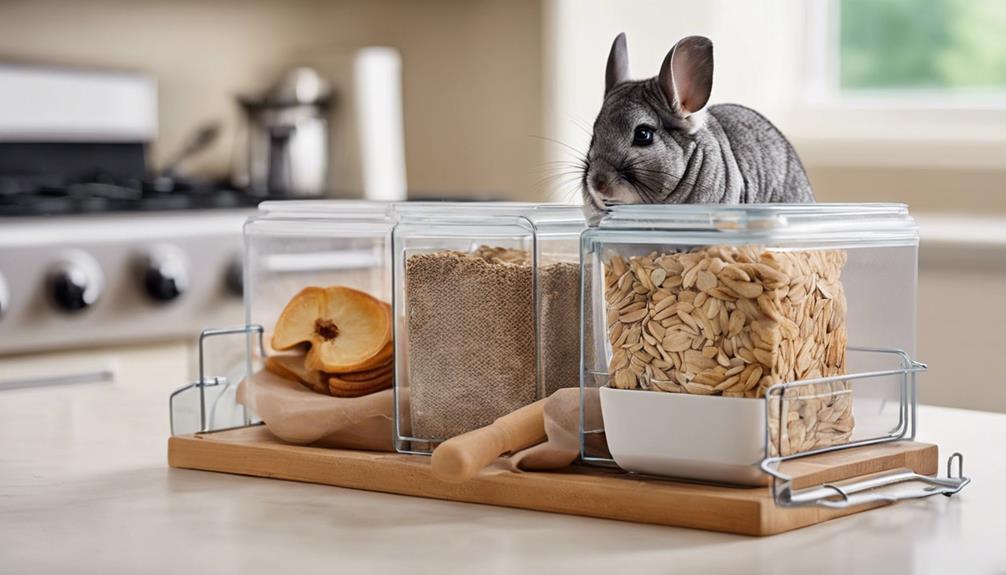
Prepare your homemade chinchilla treats with care, ensuring they are baked to perfection and stored properly to maintain freshness. When baking for your precious pet, remember that proper portioning and fresh ingredient sourcing are key to creating healthy and delicious treats. Here are some baking and storage tips to help you in this endeavor:
| Baking Tips | Storage Tips |
|---|---|
| 1. Use chinchilla-safe ingredients. | 1. Store treats in an airtight container. |
| 2. Follow the recipe precisely. | 2. Keep treats in a cool, dry place. |
| 3. Monitor baking time carefully. | 3. Check for any signs of spoilage. |
| 4. Let treats cool completely before serving. | 4. Discard treats past their expiration date. |
Avoiding Harmful Foods
Guarantee the safety of your chinchilla's diet by meticulously avoiding any harmful foods that could jeopardize its well-being. When it comes to food safety and ingredient toxicity, your chinchilla's health should always be the top priority. Here are four items to keep in mind:
- No Sugary Treats: Chinchillas have delicate digestive systems that can't handle sugary foods. Avoid sugary treats like candies or sugary fruits to prevent digestive issues.
- Say No to Processed Foods: Processed foods often contain additives and preservatives that can be harmful to your chinchilla. Stick to natural, whole foods for a healthier diet.
- Watch Out for Nuts: While nuts can be a tasty snack for humans, they're high in fat and can be hard for chinchillas to digest. Avoid nuts to prevent potential health problems.
- Steer Clear of Citrus Fruits: Citrus fruits are too acidic for chinchillas and can cause digestive upset. Opt for chinchilla-safe fruits like apples or grapes instead.
Introducing Treats to Your Chinchilla
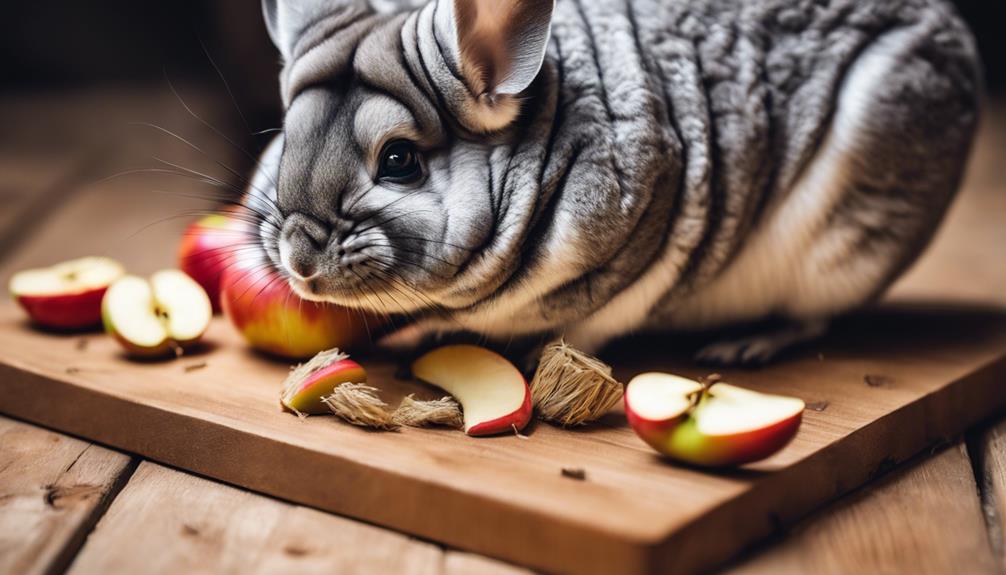
To introduce treats to your chinchilla, start by offering small portions of chinchilla-safe fruits and vegetables as a delightful addition to their diet. Treat introduction holds numerous benefits beyond just enjoyment for your furry friend. These treats can be used effectively in training your chinchilla, encouraging positive behavior through positive reinforcement. By associating treats with desired actions, you can mold your chinchilla's behavior in a gentle and loving manner.
| Treat Type | Benefits | Examples |
|---|---|---|
| Fruits | Rich in vitamins | Apple, Blueberries |
| Vegetables | High in fiber | Carrots, Bell Peppers |
| Hay-Based Treats | Dental health promotion | Timothy Hay Cubes |
Monitoring Treat Consumption
When observing your chinchilla's overall well-being, it's prudent to carefully monitor their treat consumption to guarantee a balanced and healthy diet. Here are four essential points to bear in mind when monitoring your chinchilla's treat intake:
- Treat Moderation: Just like humans, chinchillas need to enjoy treats in moderation. Excessive treats can lead to health risks such as obesity and digestive issues.
- Behavioral Changes: Keep an eye out for any behavioral changes in your chinchilla. If they start showing signs of overexcitement or constantly beg for treats, it might indicate treat overconsumption.
- Portion Control: Control the portions of treats you give your chinchilla. Too many treats can disrupt their balanced diet and lead to nutritional imbalances.
- Consult a Veterinarian: If you notice any concerning changes in your chinchilla's behavior or health, consult a veterinarian promptly. They can provide guidance on adjusting treat consumption to make certain your chinchilla's well-being.
Frequently Asked Questions
Can Chinchillas Eat Nuts or Seeds as Treats?
Indulging your chinchilla in nuts or seeds as treats can be risky. To maintain nutritional balance and prevent allergies or digestive issues, exercise caution with portion control. Treat their diet like a precious garden.
How Often Should I Give My Chinchilla Homemade Treats?
Offer your chinchilla homemade treats occasionally to maintain a balanced diet. Opt for healthy options like hay-based treats. Control portions to prevent overindulgence. Treat frequency should be moderate, ensuring your furry friend's well-being.
Are There Any Specific Fruits or Vegetables That Chinchillas Should Avoid as Treats?
When treating your chinchilla, remember that some foods can be toxic. Avoid unsafe options like avocado, onion, and grapes. Instead, opt for safe choices such as apples, blueberries, and carrots to keep your fluffy friend healthy and happy.
Can I Use Honey or Other Sweeteners in Homemade Chinchilla Treats?
When it comes to the sweeteners debate in homemade chinchilla treats, prioritizing chinchilla health is key. Consider natural alternatives like small portions of fruits. Sugar concerns are valid; opt for safe options. Your chinchilla's well-being is paramount.
How Can I Tell if My Chinchilla Is Enjoying the Homemade Treats I Make for Them?
You know your chinchilla is enjoying the homemade treats when they enthusiastically nibble on them, showing excitement through their body language like perked ears and a wagging tail. Treat preferences can vary, so observe their reactions closely.




